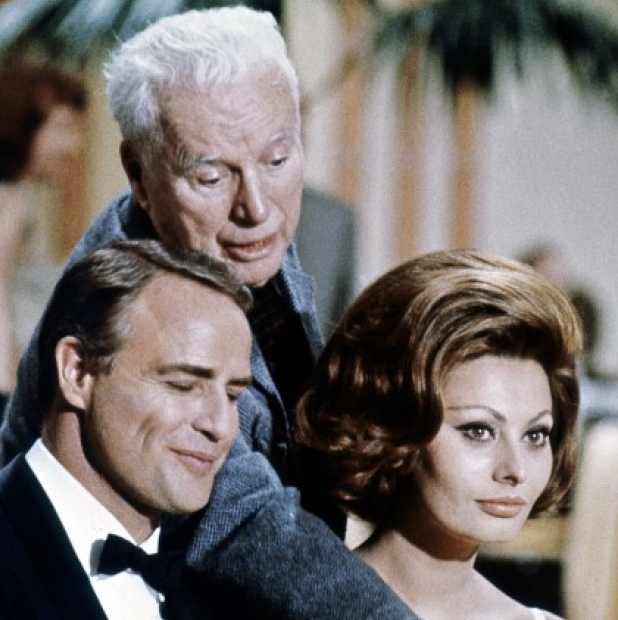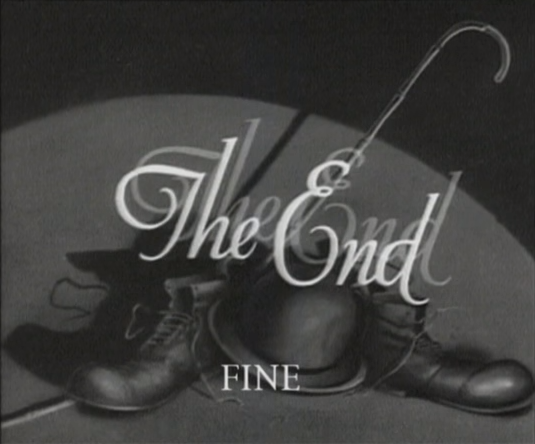Almost every artist agrees that it’s easy to begin a work of art but it’s much harder to give it a good finish. When looking at Chaplin’s career, the same tendency can be seen. The final scenes of his movies were often reshot, reimagined and reconstructed, marked by drastic changes and sudden decisions. This time, I’m going to have a closer look at five of his films where the endings we know of today might not be the ones originally intended.
1, His Favorite Pastime (1914)
Since most of the early comedies Chaplin made at the Keystone Studios were filmed without a script, they sometimes end hastily or clumsily. As a result, after watching the end of His Favorite Pastime, with a perplexed-looking Tramp facing the camera, it’s not obvious that something might be missing. Yet that’s exactly what the following review from 1914 suggests:
The producer of a Charlie Chaplin film doesn’t have to go abroad in search of color and atmosphere. For that matter, the piece of limburger cheese which shares honors with Charlie in His Favorite Pastime provides an atmosphere of its own… In the final scene we see him at the top of a telegraph pole while an enemy below is busy with an axe. Charlie lowers the limburger at the end of a string. This drives away the enemy. A typical Chaplin piece.
Keeping in mind that His Favorite Pastime was merely the eighth film Chaplin has ever appeared in, these are quite flattering words. It confirms that the Little Tramp had a very distinctive style of his own as soon as he hit the screens. Here you can watch the movie, or at least all that’s remaining, and judge for yourself whether it seems incomplete.
2, The Vagabond (1916)
There’re some suspicious things going on as far as The Vagabond’s concerned. It has a perfectly comprehensible ending, though it looks a bit optimistic when taking the rest of the film into account. At the same time, two pre-release reviews mention the following destiny of the Tramp:

An excerpt from the July 29, 1916 issue of the New York Clipper.
It’s possible that Chaplin – as he often did – had a change of heart at the very last minute and reworked the plot. Though this is nothing more than a supposition.
3, Shoulder Arms (1918)
Chaplin was always very secretive about his discarded ideas, so much so that once he ordered his cameraman, Rollie Thoteroh, to destroy all the negatives he had thrown away. For some reason, he considered the abandoned ending of Shoulder Arms worthy enough to mention it in his autobiography.
Shoulder Arms was originally planned to be five reels. The beginning was to be ‘home life’, the middle ‘the war’ and the end ‘the banqueting’, showing all the crowned heads of Europe celebrating my heroic act of capturing the Kaiser. And, of course, in the end I wake up. The sequences before and after the war were discarded. The banquet was never photographed, but the beginning was.
Luckily enough, this sequence, which was the planned beginning of the war comedy, is still available.
4, The Gold Rush (1925 & 1942)
The particular characteristic of this movie is that it has more than one endings to examine. The original 1925 release fades out after a long kiss between the Tramp and his new love. Actress Georgia Hale pointed out in an interview that it was possibly much longer than necessary.
For me, Chaplin really belonged to Lita Grey [his wife at the time], so there was a wall between us. We were very impersonal. But during the scene he had a legitimate chance to express what he evidently had been feeling – an affection for me. The kiss lasted way longer than it should have lasted. It went on and on, he kept retaking it and retaking it, so then I was quite sure that his feeling for me was more than just a director for a leading lady.
However, Chaplin decided to reissue the movie in 1942 with a new musical accompaniment composed by himself, a narration he had read out and some changes regarding the order of the scenes. In the new cut, he simply chopped off the bit where the Tramp and Georgia share a passionate kiss, as a result the film ends with the couple walking away hand in hand. Chaplin has never revealed his reasons. Here you have a chance to compare the two versions.
5, Modern Times (1936)
The ending of Modern Times might be one of the most emblematic finishing scenes in Chaplin’s whole career, yet only few know that originally he was planning a radically different farewell to the Little Tramp. This is how the chain of events would have begun according to a draft written by Chaplin himself:
On one of our adventures we come into contact with a nun. It’s just a momentary feeling or sense of beauty and the Gamin [Paulette Goddard] is moved by it. The nun is always very tender and nice to the Gamin – a pat on the hand, etc. We encounter her in the street again. The Gamin imitates her headgear and admires it. Each time the Gamin sees her she stops in the midst of the comedy and her eyes fill with tears and she says: ‘She makes me feel wicked’
It’s slightly uncertain how the story would have continued. Some sources mention a strike in the café where the Tramp is working, which he is reluctant to join in, so he is beaten up and sent to hospital. Other sources (and this possibility is supported by photographs as well) claim that after leaving the prison where he had been held captive, war is declared and the Tramp is forced to join the army. He gets a nervous breakdown and is treated in a hospital. There’s one thing we know for certain: in the meantime the Gamin has decided to become a novitiate nun.
During the shooting of all of Chaplin’s movies, everything was paintstakingly noted in the Register of Films, thus documenting every frame that was recorded on film. This is how the scenes in the hospital are described:
C.C. comes up to Paulette who is sitting on a settee. She takes his hand and he sits down. He looks at her robe inquiringly and she speaks: “I know, but it just had to be.” He withdraws hand, shrugs shoulder, says: “Can’t we be together any more?” “No, Charlie.” He puts finger to mouth in thought. She takes his hand again. He looks slightly forward and she turns her head, both very sad then look at each other again and try to smile.
In this case, the Tramp would have taken the road alone. However, Chaplin was simply not satisfied and he was searching for a better option. Let’s just say he might have found it.
 All images from Chaplin films made from 1918 onwards, Copyright © Roy Export S.A.S. Charles Chaplin and the Little Tramp are trademarks and/or service marks of Bubbles Inc. S.A. and/or Roy Export
All images from Chaplin films made from 1918 onwards, Copyright © Roy Export S.A.S. Charles Chaplin and the Little Tramp are trademarks and/or service marks of Bubbles Inc. S.A. and/or Roy Export
Sources: David Robinson: Chaplin: His Life and Art; Paul Duncan: The Charlie Chaplin Archives; David Maska & Ted Okuda: Charlie Chaplin at Keystone and Essanay; Charlie Chaplin: My Autobiography; discoveringchaplin
This is my entry for the Charlie Chaplin blogathon which I’m hosting with Christina Wehner over the weekend. Please click here if you would like to have a look at all the other amazing posts.






You have shown that the process can be just as entertaining and enlightening as the finished product.
LikeLike
I’m glad you think so. I agree that the way Chaplin had constructed his films and his mind had worked are sometimes as exciting as the movies themselves.
LikeLike
I was especially surprised by his original intentions for the ending of Modern Times! But the ending he ultimately decided on seems to work really well.
But it is comforting to know that even great director/writers like Chaplin had difficulties with endings, and actually increases my admiration for how difficult it is to create a satisfying movie. It seems like an ending can sometimes make or break a film and your post shows how conscious of that he appears to have been.
Thanks so much for inviting me to co-host! It has been delightful!
LikeLike
Thanks for your nice words! Though some may say that only the final product matters, I can only truly appreciate Chaplin as an artist knowing how much he suffered while filming.
I’m equally grateful to you for joining me.
LikeLiked by 1 person
Truthfully, I much prefer the re-issued ending for Gold Rush. There’s just something more sublime and tender about a simple hand-holding. It’s gentler, more pure.
LikeLike
There’re so many vivid opponents of the reissue but I like to take a neutral point of view. Your words have reassured me that both versions have their pros and cons.
LikeLike
Wow, I had no idea about that possible ending to Modern Times! Very interesting!
LikeLike
That’s right! I had the same reaction when I’ve learnt about it 🙂
LikeLike
Thank you for this very informative post! Charlie may have vacillated when zeroing in on an ending, but it seems he always chose the right one.
LikeLike
I agree with you. He wasn’t an easy man to be with when he was in the middle of shooting because he was constantly trying to create something perfect. It seems, he did so with great results.
LikeLike
The documentary I reviewed mentioned both the endings of Shoulder Arms and The Gold Rush, but I wasn’t aware of this alternative ending for Modern Times. Anyway, I’m glad Chaplin changed his mind, not only because the Gamin doesn’t look like the kind of character that would become a nun, but also because we already got a bittersweet ending in The Circus.
Thanks for co-hosting this wonderful event!
LikeLike
Thank you for participating. You make an interesting point: self-repetition can be boring and Chaplin successfully managed to avoid that. Unknown Chaplin is a gold mine! It’s exciting to think about how much footage there used to be and how little we can actually watch.
LikeLike
I have to say I like the hand-holding ending better in Modern Times. I didn’t realize there was a different ending planned!
That clip you posted with Chaplin and the three boys walking down the street – walking the same way – made me laugh out loud. I nearly spewed my drink of water all over my computer screen!
LikeLike
That’s one of the things I love about Chaplin. He can always surprise you :)!
LikeLike